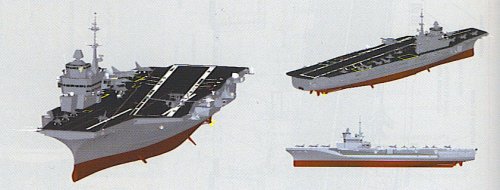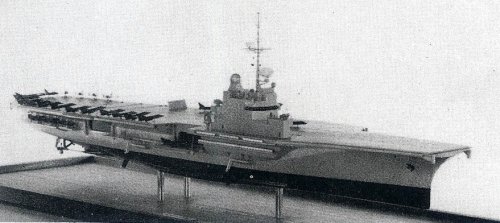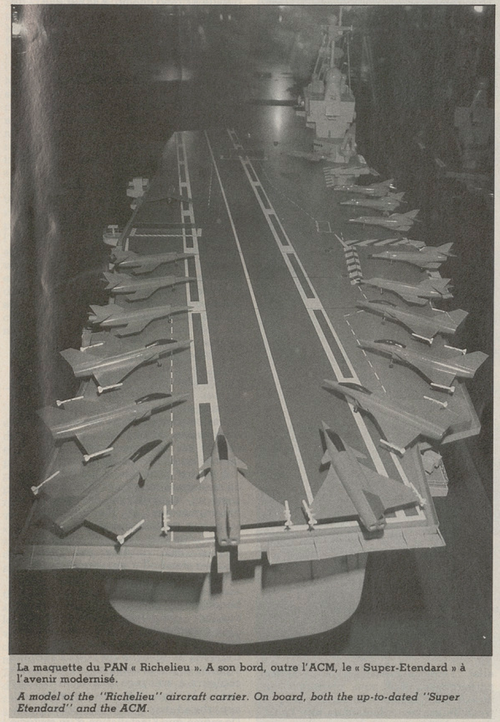You are using an out of date browser. It may not display this or other websites correctly.
You should upgrade or use an alternative browser.
You should upgrade or use an alternative browser.
Charles de Gaulle Class Unbuilt Sister Ship
- Thread starter JAZZ
- Start date
- Joined
- 3 January 2006
- Messages
- 1,224
- Reaction score
- 945
JAZZ said:follow on nuclear powered sister ship to Charles de Gaulle, was slightly larger. Would like further details if anyone has them.
The inclusion of Herakles as the main radar would indicate a fairly late date for this CGI drawing, although the idea of a nuclear powered sister ship for the CdeG wasn't truly and completely dead until early 2004.
There apparently was a proposal for a 4 reactor sister ship for the CdeG, although it is not clear whether this would have a been a 4 shaft design, or whether thinking ultimately reverted to a mere repeat of the CdeG.
- Joined
- 3 January 2006
- Messages
- 1,224
- Reaction score
- 945
JAZZ said:Prehaps include the models of CdeG or earlier concepts before cdeG was launched -
That appears to be the early Crotale armed version of the current Charles de Gaulle, which was superseded around 1986 by a SAAM 56 cell VLS arrangement, before finally assuming the current 32 cell form.
Oddly, the design of the island has never changed, and you can still see where the fore and aft 8 round Crotale launchers would have been mounted.
- Joined
- 9 October 2009
- Messages
- 22,033
- Reaction score
- 13,731
A little more background on the Charles de Gaulle and her planned sister ship, via the Forecast International archives:
In 1982, DCN Indret and Technicatome began designing the propulsion system for the new aircraft carrier Charles de Gaulle. This aircraft carrier uses two K-15 reactors. The French Navy received FFr100million in the 1982 budget to build a prototype reactor at Cadarache. The Le Triomphant class uses one of these PW reactors on each submarine, with an output of150 MW. The lead boat, the Le Triomphant, was launched in July 1993. The Charles de Gaulle uses two reactors, but because of if its substantially larger mass is not able to achieve a top speed higher than about 27 knots, while its predecessor Clemenceau class achieved 32 knots. The 61 MW turbines are from GEC Alsthom. In 1992, the French Navy radically cut back its shipbuilding plans. The second Le Triomphant class submarine was suspended, while the remaining vessels of the class were canceled. The two remaining Améthyste class submarines were also canceled. However, the French Ministry of Defense (MoD) said at the time that a second Charles de Gaulle class aircraft carrier would be built, with construction to begin in 1997.
In 1995, it was stated that the land-based prototype of the K-15 reactors for the Charles de Gaulle had developed serious cracks in the support structure, presumably necessitating remedial work that added 4,000 tons of steelwork to the ship, partly in the form of additional reactor shielding. In October 1997, the Charles de Gaulle was formally declared a nuclear installation, and a temporary plant was used to raise steam for the operation of catapults fort rials in August and October. The two reactors went critical for the first time on May 25 and June 10, 1998,respectively. Sea trials were scheduled to begin by mid-1998 and last through May 1999. However, delays affecting safety critical software and nuclear certification postponed the beginning of sea trials to November. Due to the rescheduling of the sea trials,commissioning was not expected before late 1999. No information has been obtained, however, that this has indeed taken place. It is more likely that the ship will not be fully operational until in the summer or fall of 2000. In the sea trials, the ship suffered a fire in its engine compartment and had to return to port several days short of its planned week-long engagement. The problems in the propulsion system reportedly involved“ an electric motor linked to the main engines,” according to a spokesman for DCN.
Considering the problems experienced with the aircraft carrier Charles de Gaulle, a second copy of this ship is unlikely. Even though many of the issues involved are unrelated to the nuclear reactor and some are a direct result of the program taking so long to finish, it is not realistic to expect that an approval for a second ship of this type would be obtainable either among the political decision-makers or from the general public.
BlackBat242
OK, I changed my personal text ;)
- Joined
- 10 April 2013
- Messages
- 1,482
- Reaction score
- 4,316
Then this happened, in 2000:
Apparently, the propellers from the decommissioned Clemenceau were able to be used temporarily, while new ones were made by another company - the one that made the first set not only had a nice convenient fire destroying its records... it had also declared bankruptcy between delivery of the propellers to the shipyard and the arrival of investigators.
As Clemenceau's props had smaller blades, the resulting speed made jet launches only possible with a strong headwind, so replacements had to be manufactured.
The E-2C issue was more about lack of planning - the decision to buy it was made after the ship was already under construction, at which time it was learned that the arresting gear wire pullout with the E-2C combined with its length would result in the nose gear running off the end of the angle deck before coming to a halt.
Therefore, they had to lengthen the angle deck... and the E-2C's wingspan required a few other changes to the ship to prevent hitting things.
PARIS, Dec. 16 (UPI) -- The French news media continued to denounce Saturday what it is calling a national embarrassment that -- for the first time since 1945 -- France has no aircraft carrier.
As the French daily Le Parisien put it, France actually has two aircraft carriers, but neither is seaworthy.
There is the newly-built $2.6 billion plus nuclear-powered Charles de Gaulle, now in dry dock in Toulon after one of her propellers shattered on her first, long test voyage.
The other carrier is the obsolete French vessel, Foch -- now in dry dock in Brest -- newly named Sao Paulo, and under repair before being sold to the Brazilian navy.
But the issue infuriating critics of the French Navy and bureaucracy is the 14-year saga construction of the Charles de Gaulle, widely viewed as one of the worst scandals in military purchase history.
During sea tests this year, the propeller broke as the ship entered the Bermuda Triangle. And as investigators prepared to look into why the propellor was defective and placed on the ship, a fire broke out in the factory in Nantes where the propellor was constructed. Destroyed in the blaze was correspondence between the factory, the defense ministry and the French navy on the design, building and acceptance of the ship's four 19-ton propellers.
The French government has initiated a criminal investigation into construction of the boat.
Other faults have afflicted the Charles de Gaulle - Europe's first nuclear-powered carrier since her construction began in 1986.
Listed by the dailies Le Monde and France-Soir as other faults were:
-- the need to extend the flight deck because it was too short for a US-built surveillance aircraft;
-- the need to modify the nuclear generators to satisfy safety regulations; and,
-- discovery that the thick, armored glass on the bridge was nearly opaque; and,
-- then even the ship's laundry washing machines caused problems. As originally bolted together - when used simultaneously - the vibrations were so powerful that the entire 40,000-ton ship shivered.
In the words of Liberation, repairs expected to keep the vessel in Toulon for the foreseeable future, present failings and a mystery capable of coming from a John Le Carré spy novel.
``Someone must pay for these acts which are akin to sabotage,'' said Jean-Louis Naudet, general secretary of the French Shipyard Workers Union.
And quoted in Le Monde Friday, National Assemblyman and former chairman of the defense committe, Jean-Michel Boucheron, said of the situation: "I don't believe for a moment that this was a coincidence... Something has gone wrong in the most serious way.''
Copyright 2000 by United Press International. All rights reserved.
Apparently, the propellers from the decommissioned Clemenceau were able to be used temporarily, while new ones were made by another company - the one that made the first set not only had a nice convenient fire destroying its records... it had also declared bankruptcy between delivery of the propellers to the shipyard and the arrival of investigators.
As Clemenceau's props had smaller blades, the resulting speed made jet launches only possible with a strong headwind, so replacements had to be manufactured.
The E-2C issue was more about lack of planning - the decision to buy it was made after the ship was already under construction, at which time it was learned that the arresting gear wire pullout with the E-2C combined with its length would result in the nose gear running off the end of the angle deck before coming to a halt.
Therefore, they had to lengthen the angle deck... and the E-2C's wingspan required a few other changes to the ship to prevent hitting things.
at which time it was learned that the arresting gear wire pullout with the E-2C combined with its length would result in the nose gear running off the end of the angle deck before coming to a halt
It was actually a lot more subtle than that… there never was a risk of the Hawkeye running off the edge.
The Hawkeye issue was an “edge case” (pun intended): if the Hawkeye engaged the 3rd wire, and veered to the port edge of the angled deck, and the port engine failed (increasing the turning radius), it would have insufficient turning length remaining ahead of the nose wheel, and a tow tractor would have to be used.
That was time consuming and potentially put other aircraft waiting to land at risk, so since the cost of extending the angled deck was minimal (a few million euros) it was decided to eliminate the edge case.
Last edited:
Compared to CVN-78 Gerald Ford's problems, those were trivalities. What makes you believe it is relevant to the topic PA-NG?Then this happened, in 2000:
Apparently, the propellers from the decommissioned Clemenceau were able to be used temporarily, while new ones were made by another company - the one that made the first set not only had a nice convenient fire destroying its records... it had also declared bankruptcy between delivery of the propellers to the shipyard and the arrival of investigators.
As Clemenceau's props had smaller blades, the resulting speed made jet launches only possible with a strong headwind, so replacements had to be manufactured.
The E-2C issue was more about lack of planning - the decision to buy it was made after the ship was already under construction, at which time it was learned that the arresting gear wire pullout with the E-2C combined with its length would result in the nose gear running off the end of the angle deck before coming to a halt.
Therefore, they had to lengthen the angle deck... and the E-2C's wingspan required a few other changes to the ship to prevent hitting things.
BlackBat242
OK, I changed my personal text ;)
- Joined
- 10 April 2013
- Messages
- 1,482
- Reaction score
- 4,316
Because I was answering a part of the thread discussing CdG, its intended (but canceled) sister, and the issues of the class.Compared to CVN-78 Gerald Ford's problems, those were trivalities. What makes you believe it is relevant to the topic PA-NG?
I am fully aware of the "content Nazis" on this forum who love to jump on anyone not sticking to an narrowly-defined strict interpretation of the subject of threads - but they are just static in the free-flow of information, opinion, and discussions that makes forums like this worth reading and participating in.
originary name of Charles de Gaulle in project.From Aviation magazine 15-11-1986
Similar threads
-
-
-
French nuclear-powered amphibious assault ship (PH 75/PA 75)
- Started by Triton
- Replies: 29
-
Air Defense Ship (ADS)/Indigenous Aircraft Carrier (IAC)/Vikrant-class Carrier
- Started by TinWing
- Replies: 96
-
Inspiration for the 2004 movie, 'The Terminal', passes away
- Started by Grey Havoc
- Replies: 1



